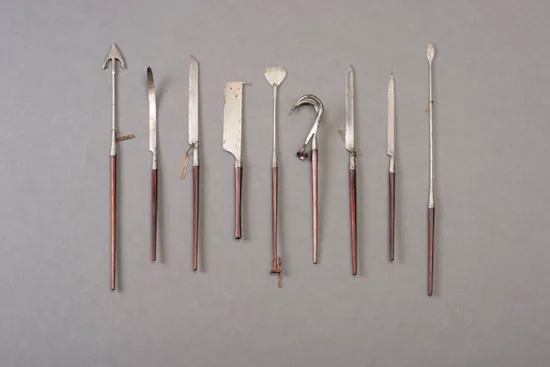A Superb and Rare Collection of 28 Steel and Wood Scale Model Whaling Instruments
A Superb and Rare Collection of 28 Steel and Wood Scale Model Whaling Instruments
Contained in their original mahogany box with a silver plaque on the inner lid inscribed: ‘A Model of Instruments and Apparatus used in Greenland Whale Fishery. Made by T Piercy 1820’
Some implements with their own steel labels attached: ‘Flinching Spade’, ‘Spear Harpoon’, ‘Strand Knife’, etc.
Circa 1820
Size: 9.5cm high, 30cm wide, 10cm deep – 3¾ ins high, 11¾ ins wide, 4 ins deep
Contained in their original mahogany box with a silver plaque on the inner lid inscribed: ‘A Model of Instruments and Apparatus used in Greenland Whale Fishery. Made by T Piercy 1820’
Some implements with their own steel labels attached: ‘Flinching Spade’, ‘Spear Harpoon’, ‘Strand Knife’, etc.
Circa 1820
Size: 9.5cm high, 30cm wide, 10cm deep – 3¾ ins high, 11¾ ins wide, 4 ins deep
Although called the ‘Royal Fish’ of English monarchs the whale is nethertheless a warm blooded mammal. At birth a baby blue whale measures over 20 feet which makes him larger than any fully grown land animal. For sheer size the blue whale is larger than any known prehistoric dinosaur. A blue whale of 89 feet; weighed 119 tons, the equivalent to 20 elephants, and yielded 166 barrels of oil. In absolute strength the whale is the strongest creature on earth. When he travels at the rate of 10 knots an hour the whale develops about 47 horsepower and can tow a killer boat up to seven hours before reaching exhaustion. Whales have been known to wreck whale-ships and in 1820 the American ship ‘Essex’ was rammed twice by a sperm whale and sank in ten minutes.
English whaling gear of the early 19th century was illustrated in William Scoresby Jr’s. book ‘An Account of the Arctic Regions with a history and description of the Northern Whale Fishery’. Published in 1820 the apparatus shown is identical to the model instruments in this collection. William Scoresby Jr. was one of the most famous whaling Captains and the son of another successful whaler William Scoresby Snr., of Whitby in Yorkshire. As well as whaling he explored and mapped the coasts along which he fished and made observations on natural history, meteorology and oceanography. He invented many improvements in whaling gear, as had his father who devised the barrel like ‘crow’s nest’ to replace the flimsy canvas protection for the lookout at the master-head. It is very probable that these model instruments were made to demonstrate and reflect William Scoresby Jr’s. inventions and improvements.
English whaling gear of the early 19th century was illustrated in William Scoresby Jr’s. book ‘An Account of the Arctic Regions with a history and description of the Northern Whale Fishery’. Published in 1820 the apparatus shown is identical to the model instruments in this collection. William Scoresby Jr. was one of the most famous whaling Captains and the son of another successful whaler William Scoresby Snr., of Whitby in Yorkshire. As well as whaling he explored and mapped the coasts along which he fished and made observations on natural history, meteorology and oceanography. He invented many improvements in whaling gear, as had his father who devised the barrel like ‘crow’s nest’ to replace the flimsy canvas protection for the lookout at the master-head. It is very probable that these model instruments were made to demonstrate and reflect William Scoresby Jr’s. inventions and improvements.
A Superb and Rare Collection of 28 Steel and Wood Scale Model Whaling Instruments

SOLD






